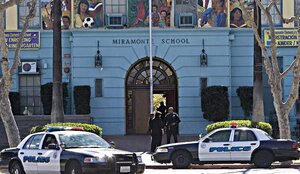Who is to blame for LA school sex abuse? Push for answers poised to escalate.
Three suits involving 23 students have been filed in an L.A. court in the wake of the Miramonte school sex abuse scandal, but the those numbers are expected to rise dramatically in a push for accountability.

Police patrol in front of the Miramonte Elementary school in Los Angeles, California, Thursday. The school reopened on Thursday after it was closed for two days as Los Angeles County school officials temporarily replaced the entire staff following the arrests of two teachers.
Jonathan Alcorn/Reuters
Los Angeles
As the child sex abuse scandal that has rocked the Miramonte Elementary School and the Los Angeles Unified School District expands, a dramatic push for accountability is just beginning to take off.
Three suits involving 23 Miramonte students have been filed in Los Angeles Superior Court so far, and according to a spokesman for the law firm handling them, “that number will go up to eight or nine by the end of next week.”
While only two men have been arrested and charged so far in the Miramonte scandal, experts say statistics collected from previous pedophile cases suggest the number of alleged instances of abuse, and lawsuits, could rise far further.
But as the estimated cost to the school district of handling the fallout from the abuse allegations escalates the question arises, who can and should be held liable when a teacher breaches the public trust?
The cases that have been filed so far target both the individual teachers as well as the school district, which, according to a spokesman, has no comment.
[ Video is no longer available. ]
“We believe it is very dangerous to place blame for child sexual abuse on anyone or any group other than the perpetrator of the crime,” says Jolie Logan, CEO of Darkness to Light, a national nonprofit dedicated to the prevention of child sexual abuse.
Still, she notes, cases such as this one “provide an opportunity for all of us to consider our roles. It is time to closely examine what could have been done differently, what warning signs may have been missed and what policies should now be adopted and enforced to keep kids safe.”
But California, unlike more restrictive states such as Texas, allows individuals to sue school districts, points out Pace Law School professor Emily Gold Waldman, who is chair of the Association of American Law Schools Section on Education Law.
For the suits to go forward, “they must have some sort of theory such as negligence,” she says, but there is nothing preventing the plaintiffs from attempting to assign liability to anyone such as a principal or anyone else in a supervisory position. She notes that California law has stated that school districts must “take reasonable steps to protect its students.”
The current claims involve alleged abuse that took place between 2005 and 2010. However, additional victims, some dating back to 1994, are emerging to buttress the current abuse cases. This week, police obtained 200 more photographs revealing “inappropriate” actions by one of the two teachers that have been arrested, bringing the total to some 600 so far.
New Jersey attorney Gregory Gianforcaro, who was abused by a community priest when he was a child, has litigated more than 200 child sexual abuse cases and says it’s hard to hear about cases such as this.
“This guy has been teaching there for 32 years,” he says, referring to one of the two teachers. While he respects the swift and dramatic action taken by the district this week when it replaced the entire elementary school staff, he says, “where were they for the last 32 years?”
Mr. Gianforcaro notes that statistics on pedophile behavior point to multiple offenses as the norm. “Statistics show that most pedophiles abuse an average of 117 children,” he says.
Even if the suits proceed, it is highly likely that they will result in a settlement rather than going to court, says criminal defense attorney Christopher Leibig.
“These cases are very hard to prove,” he notes, because plaintiffs must show that there were reasonable grounds to believe that a supervisor knew what was going on or had acted in a negligent manner when told. School districts are highly motivated to keep these cases out of court because they do not want an open season on what it might have done wrong in the past. “They do not want the dirty laundry airing in a public court,” he says, adding “it is good public relations for the district to settle and it will bring money to the plaintiff.”
Nonetheless, says Gianforcaro, schools across the country should take this as a wake-up call. “Penn State, Syracuse, and now this case are just the tip of the iceberg,” he says, adding, “we have only just begun to tackle this issue.”
The courts may determine financial liability, but society and parents already have clear expectations of schools, says Brooklyn Law School professor Lisa Smith. The expectation of parents, students and society is that educational institutions teach, supervise, and can be entrusted with the care of young people.
“That basic belief means that when sexual abuse occurs in an institution everyone expects a thorough investigation of how this happened, who knew, what were the signs and who should have known,” she says via email, adding that “it is the responsibility of every member of the staff – up to and including the principals, deans and others, to protect the young people with whom they are working.”

